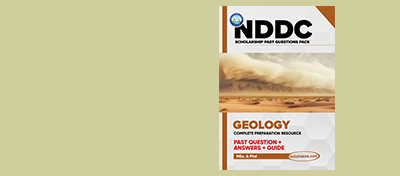NDDC Scholarship Geology Past Questions And Answers [Free – Download]
Welcome to the captivating world of NDDC Geology, where ancient rocks and hidden treasures hold the keys to unlocking Earth’s geological history. In this blog post, we invite you on a thrilling journey into the realm of geology, exploring the National Department of Development and Control’s (NDDC) comprehensive collection of geological resources. Whether you’re a seasoned geologist or a curious enthusiast, prepare to be enthralled by the wonders that lie beneath the surface. we have curated the ultimate resource – Past Questions and Answers!
At the heart of NDDC Geology, lies an unparalleled geological database, meticulously curated by experts and accessible to researchers, students, and professionals alike. Delve into a vast repository of geological maps, surveys, and reports spanning various regions, ages, and geological phenomena. With NDDC’s comprehensive resources at your fingertips, the possibilities for geological exploration are limitless.
To excel in any examination, preparation is key, and that’s where our NDDC Scholarship Geology Past Questions and Answers come into play. These carefully selected materials provide you with a glimpse into the exam’s structure, question formats, and the depth of knowledge expected.
With our Past Questions and Answers, you can sharpen your problem-solving skills, enhance your understanding of critical concepts, and build confidence in tackling even the most challenging questions. Practicing with real past exam papers is the best way to simulate the actual test environment. This is your stepping stone towards achieving your dreams and creating a lasting impact on society.
1. Pick the option which is not the cause of folding.
A) Folding due to tangential tension
B) Folding due to tangential compression
C) Folding due to intrusions
D) Folding due to differential compression
Answer: a
Explanation: The various causes of folding that are studied are, folding due to- tangential compression, intrusions and differential compression. Hence first option is not correct.
2. The rock mass which is capable of yielding the contained water economically
A) Aquifer
B) Aquiclude
C) Aquifuge
D) Aquitard
Answer: a
Explanation: Aquifer is defined as a rock mass, layer or formation which is saturated with groundwater and which virtue of its properties is capable of yielding the contained water at economical costs when tapped.
3.Which among the following is not an example of good aquifer?
A) Granite
B) Gravels
C) Limestones
D) Sandstones
Answer: a
Explanation: Gravels, limestones and sandstones generally form good aquifers when occurring in suitable geological conditions and geographic situations.
4.The formation which may be porous enough to hold enough quantity of water is
A)Aquifer
B)Aquiclude
C)Aquifuge
D)Aquitard
Answer: b
Explanation: A rock body or formation which may be porous enough to hold enough quantity of water which by virtue of its other properties does not allow an easy and quick flow through it, is called an aquiclude.
5.Example for best aquiclude is
A)Granites
B)Gravels
C)Compacted clay
D)Sandstone
Answer: c
Explanation: Aquiclude is to be treated as a practically impermeable rock mass. Compacted clay formation are the best examples of aquicludes.
6.Which rock formation is absolutely impermeable?
A)Aquifer
B)Aquiclude
C)Aquifuge
D)Aquitard
Answer: c
Explanation: Aquifuge is an absolutely impermeable rock formation through which there is no possibility of storage or movement of water.
7.The branch or study which deals with behaviour of rocks under applied forces is called
A)Soil mechanics
B)Rock mechanics
C)Lithology
D)Geology
Answer: b
Explanation: Rock mechanics deals essentially with behaviour of rocks under applied force fields in natural as well as in laboratory conditions. Rock mechanics has developed at such a fast pace during last it has already become a compulsory part of advanced civil engineering practice.
8.Which material can be used as a roofing material among the following?
A)Slate
B)Granite
C)Marble
D)Gneiss
Answer: a
Explanation: Slates used in many areas as roofing material for ordinary constructions and in pavements also fall in the category of building stones.
9.Which type of compressive strength is taken as the most important index property of stones?
A)Confined
B)Drained
C)Undrained
D)Unconfined
Answer: d
Explanation: Stones like all other solids fail when subjected to loads beyond their strength. The failure takes place under compressive, tensile and shear forces at different values. It is however, the unconfined compressive strength, which is taken as the most important index property of stones.
10.What is the maximum force expressed per unit area, which a stone can withstand without rupturing?
A)Shear strength
B)Tensile strength
C)Compressive strength
D)Bending strength
Answer: c
Explanation: Compressive strength is also sometimes referred as crushing strength of a stone and may be defined as the maximum force expressed per unit area, which a stone can withstand without rupturing.
11.What is not true about unconfined test?
A)It is also called tri-axial test
B)The specimen has no lateral support
C)The specimen has no lateral restraint
D)It is also called uniaxial test
Answer: a
Explanation: The load at failure divided by the area of cross-section of the sample gives the unconfined compressive strength of the rock. The value is termed unconfined or uniaxial because the test specimen has no lateral support or restraint and is being compressed only along one axis.
12.Granite and quartzite are examples of
A)Aquifer
B)Aquiclude
C)Aquifuge
D)Aquitard
Answer: c
Explanation: Aquifuge is almost free from pores and other interstices. Examples are compact interlocking granites and quartzites.
13.Which is the rock mass where partial perviousness is caused because of profuse jointing or cracks?
A)Aquifer
B)Aquiclude
C)Aquifuge
D)Aquitard
Answer: d
Explanation: Aquitard is less common term used sometimes for an aquifuge or aquiclude that has become locally leaky due to development of partial perviousness caused because of profuse jointing or cracks.
14. Aquifers are distinguished into how many types on the basis of physical conditions under which
water can exist in them?
A)1
B)2
C)3
D)4
Answer: b
Explanation: Two basic types of aquifers are distinguished on the basis of physical conditions under which water can exist in them: the unconfined aquifer and the confined aquifer.
15.Which aquifer is called water table aquifer?
A)Unconfined aquifer
B)Confined aquifer
C)Ground aquifer
D)Connate aquifer
Answer: a
Explanation: Unconfined aquifer is also called a water-table aquifer, and is the most common type encountered in the fields.
16.What is the pressure of upper surface of unconfined aquifer?
A)Very high pressure
B)Lower than atmospheric pressure
C)Equal to atmospheric pressure
D)Greater than atmospheric pressure
Answer: c
Explanation: In unconfined aquifer, the upper surface of water or the water-table is under atmospheric pressure which may be acting through the interstices in the overlying rocks.
17.What is the isolated water table held by a small extension of impervious rock called?
A)Underlying water
B)Secret water
C)Perched water
D)Underwater
Answer: c
Explanation: Perched water table is the term used for isolated water table in an aquifer held by a small extension of impervious rock within a large pervious tract.
18.Supplies from perched water-table are reliable as source of water. State true or false.
A)True
B)False
Answer: b
Explanation: Supplies from perched water-table which are isolated reservoirs are often not reliable as
source of water.
18.What is the upper surface of water in a confined aquifer called?
A)Primary layer
B)Secondarylayer
C)First layer
D)Peizometric layer
Answer: d
Explanation: Naturally water held in confined type of aquifer is not under atmospheric pressure but under a greater pressure due to the confining medium. The upper surface of water in a confined aquifer is called piezometric surface.
19.At many places where is the piezometric surface with respect to the ground level?
A)Below
B)Same level
C)Above
D)Inclined to ground level
Answer: c
Explanation: Artesian aquifer is, in fact, confined aquifer of such a geometry developed in suitable
geological situations so that the mezometric surface is always above the ground level at many places when projected in elevation.
20.What is the speciality of the Artesian Water?
A)Has a characteristic colour
B)Has a characteristic odour
C)Requires no pumping
D)Requires special type of pumping
Answer: c
Explanation: When water is tapped from Artesian aquifers, it rushes up to and to great heights. Such wells are called Artesian wells, or flowing wells and the type of groundwater obtained from them, which often needs no pumping, as Artesian Water.





